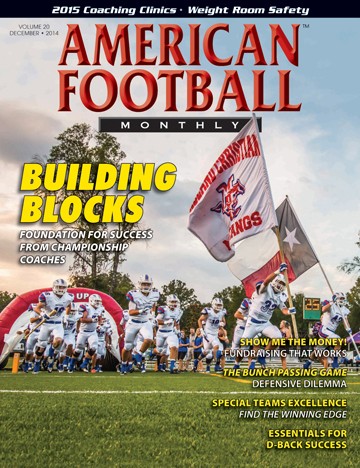Defensive Backs Techniques, Fundamentals, Tips and Drills (Part I)
by: Randy AwreyHead Coach, Concordia University (Chicago)©
More from this issue
The defensive back position today is perhaps the most physically demanding of any player. He must be able to tackle much bigger running backs and run with wide receivers that have world class speed and the height of a basketball player. Athleticism, hard work, determination and intelligence must be added to God-given talent and instinct in order to play effectively in the secondary. Here are some tips for defensive backs at all levels that you can share with your athletes.
Tips For DBs
1. Know your proper stance, alignment, responsibility and technique on every play. Others are depending on you to do your job.
2. Know the defense that was called as well as the down and distance on every play.
3. Know your keys and check for particular defenses and how to react to them. Use your scouting report to know your opponent.
4. Watch the offensive huddle break and identify the offensive formation, eligible receivers, potential deep threats and best receivers immediately. 5. Communicate with your teammates from the time the defensive huddle breaks until the play is over. More specifically:
• Talk “down and distance” and “tendencies and favorite plays.”
• Call out checks and adjustments / echo the calls.
• Everyone yell “pass/run” when play is recognized.
• Everyone yell “ball” when the pass is thrown.
• When a receiver crack blocks, yell “crack” and “fill the crack.”
• When a receiver leaves your zone yell “cross,” “in,” “curl,” “hole,” etc.
6. The deep secondary will play every play as a pass first, run second. Never be beat by the pass or the run. Always keep the ball inside and in front of the secondary.
• Be “as wide as the widest” and “as deep as the deepest” receiver.
• Be sure the ball crosses the LOS before you commit yourself to run support.
• Cover your zone/man until the whistle blows or the ball does cross the LOS.
• Never let a receiver get behind you.
• Never cover the curl/hook until the ball is in the air.
7. Know where your help will be in different defenses.
8. Learn to play field position.
• Use the sideline as a 12th man.
• Use the hash marks and yard lines.
• Close up your alignment from your 20 yard line to your goal line - never line up in the end zone.
9. Make every receiver and ball carrier pay a big price for every catch or yard with relentless pursuit and aggressiveness.
• Punish the receivers – undress the receiver – explode through the receiver.
• Meet running plays as close to the LOS as possible.
• Be sure of your tackles. The first tackler must securely wrap-up the opponent rather than look for the big hit.
10. Identify and recognize pass patterns as they develop. Never chase a receiver leaving your zone unless the ball is thrown - call and talk the receiver to the next zone. If no receiver shows in your zone, continue to gain depth, keeping your head on a swivel, looking for receivers entering your zone.
11. Never get knocked off your feet. As a last resort, trade time for yardage in order for pursuit to get to the play.
12. Always sprint to the ball when it is thrown, be there for the tip, the interception, the fumble, or the tackle.
• Never go in front of the receiver, unless you can get two hands on the ball. Look the ball into your hands.
• When batting the ball down, reach with your far arm so that you can hang/hammer the receiver with the upfield arm.
• Always go through the receiver to the ball high at the shoulders and head.
• Always go for the ball at its highest point.
• Yell “BINGO” when the ball is intercepted.
• Return the interception to the near sideline.
• The closest defender to the interception should block the intended receiver.
13. In man coverage, key the ball for quick reads, then concentrate on the belt buckle or hips - where his belt buckle goes, he goes.
• When the receiver slows down, straightens up or chops his steps, be ready to drive on him.
• Look for the ball when the receiver looks.
14. Keep your weight on the balls of your feet, stay low and don’t get on your heels.
15. ALWAYS work your drills at full speed.
Basic Fundamentals (may vary slightly by position)
Stance:
1. Narrow base with feet close together and no wider than hips
• This helps to react and move quicker.
• It is a matter of physics. It is easier to displace body position if you don’t have a wide base.
• It helps with your backpedal technique.
2. Stagger your feet with a toe to heel relationship. This is referred to as a vertical stagger.
3. Put the outside foot forward… it makes it easier to look at keys and permits backward movement as quickly and efficiently as possible.
• Point the outside foot slightly inward.
• The forward foot is your push-off foot.
4. The majority of weight should be placed on the ball of the front foot.
• Roll the weight toward the big toe on the front foot.
• Another technique is to think the weight up onto the toes of the front foot.
5. Bend the knees slightly and lower the hips. This flexion enables a quicker reaction and helps to facilitate the initial backward movement which is a rapid push backwards. If they’re not bent, your first movement will automatically be to bend your knees at the snap.
6. Bend at the waist at approximately a 45-degree angle, with your back slightly rounded and the shoulders forward toward the LOS.
• The hips should face the LOS.
• The head and shoulders should be above or in front of the forward foot.
• The emphasis is on the body lean. This prevents the body from straightening up too soon on the back pedal.
• Pull the chin close to the body… this helps to maintain forward lean and the ability to react forward after the backpedal.
7. Don’t dip before moving. It is essential to move backwards immediately at the snap, not down and then back. A “false dip” will enable the receiver to get a two step movement advantage.
8. Allow your arms to hang in a loose, relaxed manner over the front foot.
Start
1. Move on the snap - do not rock or tip your movement.
2. Push off the front foot. Step backward while keeping head, arms and shoulders forward. Do not allow hips to come forward, as you will lose a step.
3. Reach back on step and sit down. This makes it easier to move laterally. It also helps to eliminate crossover steps and to maintain cushion.
4. Maintain desired forward body lean position.
5. Keep weight up on the balls of the feet.
6. Keep your feet low to the ground, “skimming the turf,” using a controlled stride length.
7. The first three steps are crucial - they put you in the proper position, both vertically and horizontally, to cover the receivers and to play the ball after reading the play. We will refer to them as the “read and position” steps. They also help vs. play-action passes and will make it difficult for the QB to read the coverage.
8. Use peripheral vision on the QB and receiver.
9. Vigorously pump the arms. You can accelerate a change of direction by whipping the near arm in the intended direction of movement.
10. Keep the chin over the toes and the shoulders over the knees.
11. Maintain an even distribution of weight. This will enable you to move in any direction.
12. ALWAYS maintain a 3 to 5-yard cushion with leverage, both horizontally and vertically.
13. Adjustments to receivers getting head-up and DB leverage:
• To counter such releases, you must be able to backpedal at a 45-degree angle to the LOS (weave).
• Be careful to maintain original cushion, with outside leverage to keep your hips facing LOS. Don’t turn your hips.
Backpedal Technique
1. You should backpedal at about ¾ speed of your full potential. This will enable you to gather, come under control and break effectively in the direction the receiver breaks. If you are backpedaling at full speed, then you cannot react to a pass or come under control prior to breaking on any short or medium distance route.
2. To backpedal, you should reach back with each step and pull the weight over the feet just as if you were running forward, with the weight on the balls of your feet.
3. Raise the feet only high enough from the ground to have the cleats clear the grass. Speed is gained only when the feet are in contact with the ground. Lifting the feet too high is wasted motion.
4. Use small to medium sized, controlled steps. Do not over-stride.
5. Both knees should be bent to permit the feet to extend back past the hips.
6. Work to maintain the upper body parts in the same original position prior to the snap. Keep the chin pulled down, the head and shoulders out in front of the forward foot, and the trunk at a forward lean.
7. Move the arms in a normal relaxed manner with the elbows in at a 90-degree angle. Move them in a pumping motion. Keep the elbows in to the sides and don’t cross your arms in front of your body.
8. Stay in your backpedal as long as possible. You should be able to backpedal 15 yards before turning and running.
Weave
You should be able to change the angle of your backpedal without crossing your feet (Diagrams 1 and 2).To keep in your backpedal, you must swing around with the leg opposite the direction that you wish to go. This is a difficult move to master and will require a lot of practice, but by using this technique the receiver will not be able to turn on you.
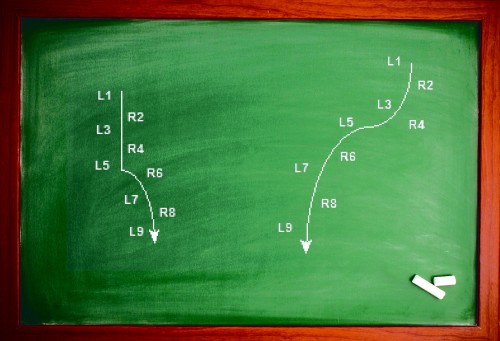
Diagram 1 & 2.
- Know the angle you need to take.
- Swing the leg opposite the direction you want to go.
- Do not cross your feet.
Break and Recovery
1. The secret to recovering when a receiver makes his final break is to close on the receiver in his receiving area that we call the interception point. Once you close, then pick-up the flight of the ball. Don’t look up for the ball until in-stride with the receiver.
- To accomplish this, you must plant your foot, lower your hips, whip your body and drive to the interception point. This is called the “heel click” technique.
- Stop and step directly back at the receiver on his final break. Don’t take an extra step.
- A lower center of gravity will aid in lateral movement.
- On deep routes, when moving away from the ball, don’t turn your head to locate it. This will slow you down. Instead, accelerate whenever you turn your head to find the ball.
2. Turn and run when the receiver gets closer than 3 yards - go with him, don’t get beat deep.
3. When you hear “BALL” called, look to intercept. You must develop split-vision to see the ball in flight plus keeping an eye on the receiver.
4. You must be able to recognize all primary routes. Upon recognition, sprint to the interception point of the route.
Change Direction – Heel Click
When you are forced to leave your backpedal, you must learn the heel click (or negative lead) technique. You must push off the opposite foot in the direction you want to go. Throw your elbows, shoulder and hips in the direction you need to go and roll over the leg nearest the desired direction. Always have a shorter lead step to ensure a power angle in your lead step. This short step will give a heel click effect (Diagrams 3-6).
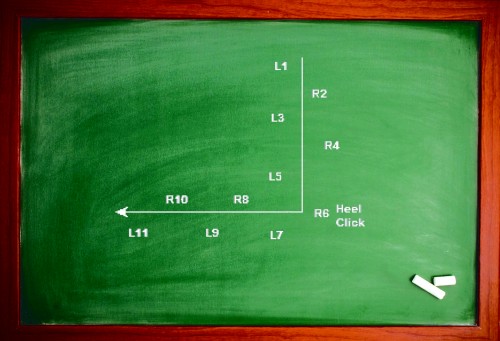
Diagram 3.
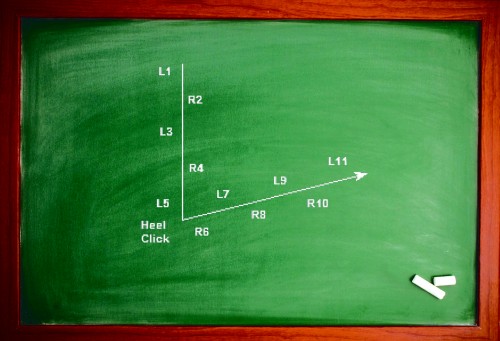
Diagram 4.
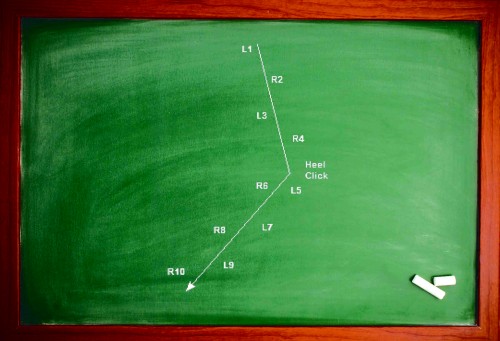
Diagram 5.
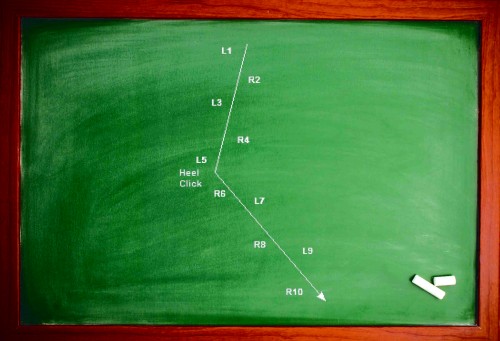
Diagram 6.
Changing Direction – Pivot (Diagrams 7 and 8)
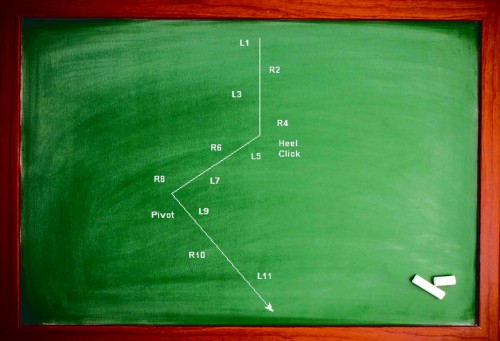
Diagram 7.
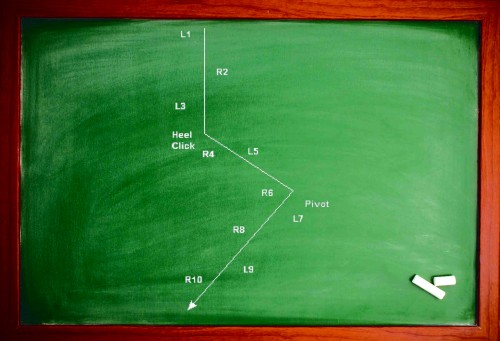
Diagram 8.
Once you have come out of your backpedal, used your heel click, closed on the receiver and if then the receiver breaks in the other direction, don’t try to heel click again. This will cause you to lose valuable steps and yardage. Instead, pivot off the opposite foot in the direction you are going and get your head, shoulders and hips around as quickly as possible. Run to the most dangerous area.
In part II next month, we will talk about playing the ball, playing the blocker, secondary run support and pursuit patterns, interception points, and stripping the receiver.
About the Author: Randy Awrey just completed his second season as head coach at Concordia University in Chicago. A four-year starter at Northern Michigan, he first became a head coach in 1990 at Kentucky Wesleyan University. Awrey then became head coach at Lakeland College and later at Saginaw Valley State. He then became defensive coordinator at Northern Michigan and then held the same position at Marietta College before becoming the head coach at Concordia.
